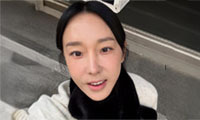[한글 번역] ‘Funeral Buddhism’ Faces Its Own Death

Ryoko Mori, a Buddhist priest, conducts a rite marking the anniversary of a family forebear’s death. Such ceremonies are becoming rarer in Japan.
By NORIMITSU ONISHIOGA, Japan - The Japanese have long taken an easygoing approach to religion, ringing out the old year at Buddhist temples and welcoming the new year, several hours later, at Shinto shrines. Weddings hew to Shinto rituals or, just as easily, to Christian ones.
When it comes to funerals, though, the Japanese have traditionally been inflexibly Buddhist - so much so that Buddhism in Japan is often called “funeral Buddhism,” a reference to the religion’s former near-monopoly on the elaborate, and lucrative, ceremonies surrounding deaths and memorial services.
But that expression also describes a religion that, by appearing to cater more to the needs of the dead than to those of the living, is losing its standing in Japanese society.
“That’s the image of funeral Buddhism: that it doesn’t meet people’s spiritual needs,” said Ryoko Mori, the chief priest at the 700-year-old Zuikoji Temple here in northern Japan. “In Islam or Christianity, they hold sermons on spiritual matters. But in Japan nowadays, very few Buddhist priests do that.”
Mr. Mori, 48, the 21st head priest of the temple, was unsure if it would survive into the tenure of a 22nd.
“If Japanese Buddhism doesn’t act now, it will die out,” he said. “We can’t afford to wait. We have to do something.”
Across Japan, Buddhism faces problems, some familiar to religions in other wealthy nations, others unique to the faith here. The lack of successors to chief priests is jeopardizing family-run temples nationwide. While interest in Buddhism is declining in urban areas, the religion’s rural strongholds are being depopulated, with older adherents dying and birthrates remaining low.
Perhaps most significant, Buddhism is losing its grip on the funeral industry, as more and more Japanese are turning to funeral homes or choosing not to hold funerals at all.
Here in Oga, on a peninsula of the same name in Akita Prefecture, Buddhist priests are looking at the reality of a population and local fishing industry in decline.
“It’s not an exaggeration to say that the population is about half of what it was at its peak and that all businesses have also been reduced by half,” said Giju Sakamoto, 74, the 91st head priest of Akita’s oldest temple, Chorakuji, which was founded around the year 860. “Given that reality, simply insisting that we’re a religion and have a long history - Akita’s longest, in fact - sounds like a fairy tale. It’s meaningless.”
Not only has the number of temples in Japan been dipping - to 85,994 in 2006, from 86,586 in 2000, according to the Japanese Agency for Cultural Affairs - but membership at many temples has fallen.
On a recent morning, Mr. Mori, the priest of the Zuikoji Temple, began the day with a visit to a rice farming household marking the 33rd anniversary of a grandfather’s death. Bowing before the home altar, Mr. Mori prayed and chanted sutras. Later, he repeated the rituals at another household.
Increasingly, many Japanese, especially those in urban areas, have eschewed such traditions. Many no longer belong to temples and rely on funeral homes when relatives die. As recently as the mid-1980s, almost all Japanese held funerals at home or in temples, with the local Buddhist priest playing a prominent role.
But the move to funeral homes has sharply accelerated in the last decade. In 1999, 62 percent still held funerals at home or in temples, while 30 percent chose funeral homes, according to the Consumers’ Association. But in 2007, the preferences were reversed, with 28 percent selecting funerals at home or in temples, and 61 percent opting for funeral homes.
In addition, an increasing number of Japanese are deciding to have their loved ones cremated without any funeral at all, said Noriyuki Ueda, an anthropologist at the Tokyo Institute of Technology and an expert on Buddhism. “Because of that, Buddhist priests and temples will no longer be involved in funerals,” Mr. Ueda said.
‘장례식의 불교’가 죽음을 직면하고 있다.
일본 국민들은 종교에 관해서는 좀 더 쉬운 접근 방법을 택해 왔다. 불교 사원에서 종을 치며 송년 행사를 갖고, 몇 시간 뒤에는 ‘신토’ 사당에서 새해를 맞이한다. 결혼식은 신토 의식을 따르거나 혹은 크리스찬 방식을 따른다.
다만 장례식에 관해서는 단호히 정통 불교식을 고수하는데 이 때문에 일본에서는 불교가 ‘장례식의 불교’라고 불릴 정도다. 이는 정교하면서도 돈벌이가 되는 죽음 혹은 추모식 관련 행사에는 형식적이고 거의 독점적인 불교의 특성을 반영한다.
그러나 이 같은 표시는 살아 있는 사람들보다 죽은 사람들의 요구를 만족시키는 것으로 보임으로써 일본 사회에서 설 곳을 잃어가고 있는 종교를 묘사하고 있기도 하다.
“그것이 ‘장례식의 불교’의 이미지입니다. 즉 사람들의 영적인 갈급함을 충족시키지 못하는 것이죠” 일본 북부지역에서 700년의 역사를 자랑하는 주이코지 사원의 료코 모리 주지 스님이 말한다.
“이슬람 혹은 크리스찬 문화에서는 영적인 문제에 관한 가르침을 제공합니다. 그러나 최근 일본에서는 이 같은 가르침을 제공하는 불교 지도자가 거의 없습니다”
현재 48세로 주이코지 사원의 21번째 주지스님인 모리스님은 22번째 주지스님이 나올 때까지 사원의 토지 보유권을 유지할 수 있을지 확실치 않다.
“만약 일본의 불교가 뭔가 행동을 취하지 않으면 이대로 소멸할 것입니다” 그가 말했다. “더 이상 기다릴 재정적 여유가 없습니다. 무엇인가를 시도해야 합니다”일본 전역에서 불교는 여러 문제에 직면한 상태다. 어떤 문제는 다른 강대국의 종교들이 갖고 있는 것과 비슷한 문제이기도 하지만, 어떤 문제는 이 지역 신앙에 관련된 독특한 것이다.
주지 스님의 후임자가 부족한 현상은 전국적으로 가문에 의해 운영되는 사원들을 위협하고 있다. 도심지에서 불교에 대한 흥미가 감소되는 한편 시골지역에서도 나이 든 열성신자는 사망하고 출생률은 낮은 상태가 유지되는 이유로 시골의 열성인구도 줄어드는 상황이다.
아마도 가장 두드러진 이유는, 점점 많은 일본인들이 장례식을 집에서 치르거나 혹은 장례식 자체를 생략하는 등 불교가 장례 사업에서 지배력을 잃어가기 때문이다.
아키타 프레펙처의 같은 이름의 반도에 위치한 이곳 오가만 해도 불교 주지스님들이 인구와 지역 어업 사업이 하향기에 접어 든 현실을 직시하고 있다.
“가장 성행했던 시절에 비해 인구나 사업규모가 절반 수준이라 해도 과언이 아닙니다” 올해 74세며 지난 860년에 세워져 아키타의 가장 오래된 사원인 초라쿠지 사원의 91번째 주지스님인 기주 사카모토 스님이 말한다. “이 같은 상황을 볼 때 우리가 가장 오래된 역사를 갖고 있는-사실 아키타의 가장 오래 된 사원이긴 하다-종교라고 우기는 것 자체가 거짓말 같은 동화라는 이야기죠. 아무 의미 없습니다”
비단 일본내 불교사원의 숫자만 곤두박질 친 것이 아니라-문화 사업에 관한 일본 기관의 보고에 따르면 2000년도에는 86,586개였으나 2006년 85,994개로 줄었다-사원 내 회원들도 급속히 줄었다. 최근 주이코지 사원의 모리 주지스님은 쌀농사를 짓는 한 가정을 찾아 그들 조부의 33번째 추도식을 자신의 사원에 의탁하도록 마케팅을 하는 것으로 하루를 시작했다. 그는 그 집에 들어서기 전 절을 한 뒤 경전을 외었고 이후, 다른 가정을 찾아 같은 일을 반복했다.
최근 점점 더 많은 일본인들, 특히 도심에 사는 사람들은 이 같은 전통을 멀리해 왔다. 많은 사람들이 더 이상 사원에 소속되지 않았으며 친척이 세상을 떠난 경우 집에서 장례식을 치르는 것이다. 가까운 1980년대 중반까지만 해도 대부분의 일본인들은 집 혹은 사원에서 장례식을 치렀으며, 스님이 대부분의 의식을 진행했었다.
그러나 지난 10년간 장례식을 집에서 치르는 문화는 급격하게 증가했다. 소비자 연합회에 따르면 1999년에는 62%의 사람들이 집이나 사원에서 장례식을 치렀고, 이 중 30%가 집에서 장례식을 치른다고 대답했다. 그러나 2007년에는 선호도가 뒤집혀, 28%가 집이나 사원에서 장례식을 치른다고 응했으나 61%가 집에서 치르는 장례식을 선호한다고 대답한 것으로 나타났다. 추가로, 점점 더 많은 일본인들이 사랑하는 사람을 아무런 장례식 없이 화장하기로 결정하고 있다고 도쿄 기술학교의 인류학자이자 불교 전문가인 노리유키 우에다는 지적했다. 그는 “바로 이 같은 이유로 불교 스님이나 사원은 장례식과 더 이상 관련이 없게 될 것이다”라고 덧붙였다.
<노리밋수 오니쉬 기자>
▲어휘해설
shinto: 일본의 토속 종교로 다신론을 믿는다.
shrine: 성지나 영장, 사원과 구별되는 사당
inflexibly: 단호히, 불변으로
dip: 내려가다, 곤두박질치다, 가라앉다
it’s not an exaggeration to say: ~라 해도 과언이 아니다. 과장이 아니다.
fairy tale: 거짓말 같은 동화, 꾸민 이야기
adherent: 열성신자
cremate: 화장하다, 소각하다
스마터리빙
more [ 건강]
[ 건강]이제 혈관 건강도 챙기자!
[현대해운]우리 눈에 보이지 않기 때문에 혈관 건강을 챙기는 것은 결코 쉽지 않은데요. 여러분은 혈관 건강을 유지하기 위해 어떤 노력을 하시나요?
 [ 건강]
[ 건강]내 몸이 건강해지는 과일궁합
 [ 라이프]
[ 라이프]벌레야 물럿거라! 천연 해충제 만들기
 [ 건강]
[ 건강]혈압 낮추는데 좋은 식품
[현대해운]혈관 건강은 주로 노화가 진행되면서 지켜야 할 문제라고 인식되어 왔습니다. 최근 생활 패턴과 식생활의 변화로 혈관의 노화 진행이 빨라지고
사람·사람들
more
김응화 단장, 아쿠아리움 퍼시픽 ‘헤리티지 어워드’
김응화무용단의 김응화 단장이 롱비치의 아쿠아리움 오브 더 퍼시픽이 수여하는 2025년 ‘헤리티지 어워드’의 영예를 안았다. 올해 처음 개최된 …

이정임 무용원, 팬아시아 전통예술 경연대회
남가주 최대 규모의 아시아 전통 예술 경연대회인 팬아시아 댄스 앤 드럼 대회에서 이정임무용원의 청소년 단원들이 경연에 참가해서 전체 대상 등 …
유희자 국악무용연구소, 팬아시아 전통예술대회
지난 15일 샌개브리얼 셰라톤 호텔에서 열린 남가주 최대 규모의 전통 무용대회인 팬아시아 댄스 앤 드럼 대회에서 유희자 국악무용연구소(원장 유…
송년행사 안내해드립니다
다사다난했던 2025년이 이제 종착점을 향해 달려가고 있습니다. 한 해를 잘 마무리하고 2026년 새해를 힘차게 맞기 위한 다짐을 하는 송년 …
‘군중’ 시리즈 이상원 작가 첫 LA전시회
아케디아 소재 홈갤러리인 ‘알트프로젝트’(대표 김진형)가 오는 29일(토)부터 한국 블루칩 작가 이상원이 참여하는 전시 ‘인 드리프트(In D…
많이 본 기사
- ‘쿠데타 모의’ 브라질 前대통령 징역형 집행 하루 전 체포
- 딥페이크 사기에 가장 많이 악용된 스타는 테일러 스위프트
- 시카고서 10대 집단난동 중 총격…트… 1
- 사과·尹절연 포함될까…국힘, ‘비상계엄 1년’ 메시지 수위 고심
- ‘당정대 삼각편대’ 정청래·김민석·강훈식…주목되는 광폭 행보
- SF 갓스 이미지 단원 50여명
- 임시정부가 펴낸 ‘한일관계사료집’ 복원 거쳐 공개된다
- AI탑재 곰인형이 성관계·약물 대화까지?…美 소비자단체 경고
- [특파원 시선] 트럼프도 떨게만든 물가…정책 유턴 신호탄될까
- 실타래 소재로 한 섬유 회화 선보여
- 한덕수 재판서 드러난 ‘계엄의 밤’…내란 첫 법적판단 나온다
- 삼성 사장단 파격 인사 ‘기술인재’ 박홍근 발탁
- 美 주도 종전안에 유럽 정상들 “재논의 필요”…신중·의구심
- 트럼프, 측근이었다 등돌린 의원 사임 발표에 “지지율 급락 탓”
- 조영구, 주식으로 21억 잃었는데 ‘10억’ 집값도 하락 “미용실서 아줌마 말 듣고 분양”
- 이지혜, 인중축소술 후 “남편이 하향세 탈거라 저주”→ “존재 자체로 우린 특별해” 멘탈 잡는 중
- 자고나면 부푼다… 증시 저승사자, AI 버블론
- “살 못 뺐는데”..이장우♥조혜원, 결혼 이틀 앞두고 웨딩 사진 공개
- ‘헌법존중 TF’ 본격 가동 “내란 행위 제보받는다”
- 역사적인 누리호 4차 발사 ‘카운트다운’…관람 명당 각광
- [오피셜] 손흥민-메시, 약 8만 관중 앞 맞대결 확정... 내년 MLS 개막전 격돌
- ‘김건희 계좌 관리인’ 도이치 주가조… 1
- ‘부친 빚투 논란’ 김혜성 “순간 감정 추스르지 못해, 깊이 반성한다” 사과문 공개
- 푸틴 특사 “트럼프 평화 계획은 우크라 구하기 위한 것”
- ‘케데헌’, 오스카 애니메이션상 후보자격 갖춘 35편에 포함
- ‘단 1승이면 전설이 된다’ 안세영, 호주오픈 결승 진출... 女 배드민턴 단식 최다승 경신 도전
- “로봇이 사람 두개골 깰 수 있어”…피겨AI, 前직원에 피소
- 미국 기침에 주저앉는 코스피… ‘오천피 신기루’
- 공직사회 뒤숭숭… “성과 내려면 희생 불가피”
- 트럼프 2,000달러 관세 배당 없던일로?
- 美 빠진 유엔기후총회 ‘화석연료’ 언급 빠진 선언문 내고 종료
- 뉴욕증시 거품 우려에 격동의 한 주… “월가, 더 큰 혼란 대비”
- “美, 23일 제네바서 우크라와 종전안 논의…루비오 등 참석”
- 동생 공개 후 ‘군인’ 차은우 ‘최신 근황’.. “쌍둥이 형제?” 귀까지 똑같이 ‘잘생김 DNA’
- ‘세계 최강’ 최민정, 월드투어 전종목 1위 예선 통과... 金 싹쓸이 정조준
- 李대통령, G20 정상회의 둘째날… ‘AI시대’ 국제협력 구상 밝힌다
- ‘배신자’ 찍힌 옛측근 그린 “의원직… 1
- 오늘 남아공 G20 정상회의 개막
- ‘채상병 수사외압’ 윤석열 등 12명 재판에
- 뉴욕증시, 연준·트럼프 ‘양대 풋’에 반색…동반 강세 마감
- 성시경, 매니저 배신에 끝내 눈물.. “너무 힘들지만 마음 다잡아”
- “트럼프 정부, 대법 패소 대비 대체 관세 수단 준비”
- G20 정상회의 첫날부터 ‘남아공 정상선언’ 전격 채택
- 반도체 뛰고 환율 오르고… 생산자 물가지수 0.2% 상승
- 평양 무인기 보낸 드론사… “암호화 강화” 사이버사 조언 묵살
- 이민법원 적체에… 한인들‘신분 위기’
- CDC ‘백신은 자폐증 유발 안한다’ 입장 변경…보건장관 지시
- LA항 대형 컨테이너선 화재…일부 터미널 운영 중단
- “맘다니도 트럼프도 승자”…화기애애 백악관 회동 예상밖 케미
- ‘지선 앞두고 윤 그림자’ ‘보수결집 우선’ 전략 회의론
1/5지식톡

-
 테슬라 자동차 시트커버 장착
0
테슬라 자동차 시트커버 장착
0테슬라 시트커버, 사놓고 아직 못 씌우셨죠?장착이 생각보다 쉽지 않습니다.20년 경력 전문가에게 맡기세요 — 깔끔하고 딱 맞게 장착해드립니다!장착비용:앞좌석: $40뒷좌석: $60앞·뒷좌석 …
-
 식당용 부탄가스
0
식당용 부탄가스
0식당용 부탄가스 홀세일 합니다 로스앤젤레스 다운타운 픽업 가능 안녕 하세요?강아지 & 고양이 모든 애완동물 / 반려동물 식품 & 모든 애완동물/반려동물 관련 제품들 전문적으로 홀세일/취급하는 회사 입니다 100% …
-
 ACSL 국제 컴퓨터 과학 대회, …
0
ACSL 국제 컴퓨터 과학 대회, …
0웹사이트 : www.eduspot.co.kr 카카오톡 상담하기 : https://pf.kakao.com/_BEQWxb블로그 : https://blog.naver.com/eduspotmain안녕하세요, 에듀스팟입니다…
-
 바디프렌드 안마의자 창고 리퍼브 세…
0
바디프렌드 안마의자 창고 리퍼브 세…
0거의 새제품급 리퍼브 안마의자 대방출 한다고 합니다!8월 23일(토)…24일(일) 단 이틀!특가 판매가Famille: $500 ~ $1,000Falcon: $1,500 ~ $2,500픽업 & 배송직접 픽업 가능LA…
-
 바디프렌드 안마의자 창고 리퍼브 세…
0
바디프렌드 안마의자 창고 리퍼브 세…
0거의 새제품급 리퍼브 안마의자 대방출 한다고 합니다!8월 23일(토)…24일(일) 단 이틀!특가 판매가Famille: $500 ~ $1,000Falcon: $1,500 ~ $2,500픽업 & 배송직접 픽업 가능LA…
케이타운 1번가
오피니언
 조지 F·윌 워싱턴포스트 칼럼니스트
조지 F·윌 워싱턴포스트 칼럼니스트 [조지 F. 윌 칼럼] 세계를 가장 크게 바꾼 사건, 미국 혁명전쟁
 이희숙 시인·수필가
이희숙 시인·수필가 [금요단상] 낙엽 위에 남겨진 향
 김정곤 / 서울경제 논설위원
김정곤 / 서울경제 논설위원[만화경] ‘중동판 꽌시’ 와스타

[왈가 왈부] ‘패트 충돌’ 선고에 여야 “정치 판결” “자성 촉구” 아전인수?
 수잔 최 한미가정상담소 이사장 가정법 전문 변호사
수잔 최 한미가정상담소 이사장 가정법 전문 변호사 [수잔 최 변호사의 LIFE &] 서울 가을 자락에서 만난 쉼터
 강민수 을지대 첨단학부 교수 한국인공지능학회장
강민수 을지대 첨단학부 교수 한국인공지능학회장 [기고] 디지털 주권의 토대, 소버린 클라우드
1/3지사별 뉴스

론 김 뉴욕주하원의원, 플러싱 YMCA에 건축지원금 300만불 전달
론 김 뉴욕주하원의원이‘플러싱 커먼스’(Flushing Commons)에 새롭게 들어설 예정인 플러싱 YMCA에‘건축지원금’(Capital F…
이민법원 적체에… 한인들‘신분 위기’

“함께 만들어 가는 평화의 약속”
“오늘 출범식은 단순한 시작이 아니라 한인사회와 함께 만들어가는 평화와 희망의 약속입니다. 한반도의 평화는 거대한 정치적 언어가 아닌 우리 같…
VA 34%·MD 30%만 모기지 ‘0’

UC 등록금 치솟는다 “매년 최고 5% 인상”
UC 이사회가 매년 최대 5%까지 신입생들의 등록금을 인상할 수 있는 ‘등록금 안정화 프로그램’을 통과시켜 향후 UC 학생들과 학부모들의 학비…
[알립니다]‘온정의 슬리핑백’ 보내기 운동

오늘 하루 이 창 열지 않음 닫기 



















































.png)


댓글 안에 당신의 성숙함도 담아 주세요.
'오늘의 한마디'는 기사에 대하여 자신의 생각을 말하고 남의 생각을 들으며 서로 다양한 의견을 나누는 공간입니다. 그러나 간혹 불건전한 내용을 올리시는 분들이 계셔서 건전한 인터넷문화 정착을 위해 아래와 같은 운영원칙을 적용합니다.
자체 모니터링을 통해 아래에 해당하는 내용이 포함된 댓글이 발견되면 예고없이 삭제 조치를 하겠습니다.
불건전한 댓글을 올리거나, 이름에 비속어 및 상대방의 불쾌감을 주는 단어를 사용, 유명인 또는 특정 일반인을 사칭하는 경우 이용에 대한 차단 제재를 받을 수 있습니다. 차단될 경우, 일주일간 댓글을 달수 없게 됩니다.
명예훼손, 개인정보 유출, 욕설 등 법률에 위반되는 댓글은 관계 법령에 의거 민형사상 처벌을 받을 수 있으니 이용에 주의를 부탁드립니다.
Close
x